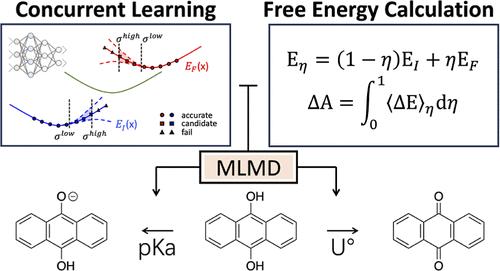当前位置:
X-MOL 学术
›
J. Am. Chem. Soc.
›
论文详情
Our official English website, www.x-mol.net, welcomes your feedback! (Note: you will need to create a separate account there.)
Accelerating Computation of Acidity Constants and Redox Potentials for Aqueous Organic Redox Flow Batteries by Machine Learning Potential-Based Molecular Dynamics
Journal of the American Chemical Society ( IF 15.0 ) Pub Date : 2024-04-24 , DOI: 10.1021/jacs.4c01221 Feng Wang 1 , Zebing Ma 1 , Jun Cheng 1, 2, 3
Journal of the American Chemical Society ( IF 15.0 ) Pub Date : 2024-04-24 , DOI: 10.1021/jacs.4c01221 Feng Wang 1 , Zebing Ma 1 , Jun Cheng 1, 2, 3
Affiliation

|
Due to the increased concern about energy and environmental issues, significant attention has been paid to the development of large-scale energy storage devices to facilitate the utilization of clean energy sources. The redox flow battery (RFB) is one of the most promising systems. Recently, the high cost of transition-metal complex-based RFB has promoted the development of aqueous RFBs with redox-active organic molecules. To expand the working voltage, computational chemistry has been applied to search for organic molecules with lower or higher redox potentials. However, redox potential computation based on implicit solvation models would be challenging due to difficulty in parametrization when considering the complex solvation of supporting electrolytes. Besides, although ab initio molecular dynamics (AIMD) describes the supporting electrolytes with the same level of electronic structure theory as the redox couple, the application is impeded by the high computation costs. Recently, machine learning molecular dynamics (MLMD) has been illustrated to accelerate AIMD by several orders of magnitude without sacrificing the accuracy. It has been established that redox potentials can be computed by MLMD with two separated machine learning potentials (MLPs) for reactant and product states, which is redundant and inefficient. In this work, an automated workflow is developed to construct a universal MLP for both states, which can compute the redox potentials or acidity constants of redox-active organic molecules more efficiently. Furthermore, the predicted redox potentials can be evaluated at the hybrid functional level with much lower costs, which would facilitate the design of aqueous organic RFBs.
中文翻译:

通过基于机器学习势的分子动力学加速水性有机氧化还原液流电池的酸度常数和氧化还原势的计算
随着人们对能源和环境问题的日益关注,大规模储能装置的开发以促进清洁能源的利用受到了极大的关注。氧化还原液流电池(RFB)是最有前途的系统之一。近年来,基于过渡金属配合物的RFB的高成本促进了具有氧化还原活性有机分子的水性RFB的开发。为了扩大工作电压,计算化学已被应用于寻找具有较低或较高氧化还原电位的有机分子。然而,由于在考虑支持电解质的复杂溶剂化时参数化困难,基于隐式溶剂化模型的氧化还原电位计算将具有挑战性。此外,虽然从头算分子动力学(AIMD)用与氧化还原对相同水平的电子结构理论描述了支持电解质,但由于计算成本较高而阻碍了其应用。最近,机器学习分子动力学 (MLMD) 已被证明可以在不牺牲准确性的情况下将 AIMD 加速几个数量级。已经确定,氧化还原电势可以通过 MLMD 计算,其中反应物和产物状态有两个独立的机器学习电势 (MLP),这是冗余且低效的。在这项工作中,开发了一个自动化工作流程来构建两种状态的通用 MLP,它可以更有效地计算氧化还原活性有机分子的氧化还原电位或酸度常数。此外,预测的氧化还原电位可以在混合功能水平上以低得多的成本进行评估,这将有助于水性有机 RFB 的设计。
更新日期:2024-04-25
中文翻译:

通过基于机器学习势的分子动力学加速水性有机氧化还原液流电池的酸度常数和氧化还原势的计算
随着人们对能源和环境问题的日益关注,大规模储能装置的开发以促进清洁能源的利用受到了极大的关注。氧化还原液流电池(RFB)是最有前途的系统之一。近年来,基于过渡金属配合物的RFB的高成本促进了具有氧化还原活性有机分子的水性RFB的开发。为了扩大工作电压,计算化学已被应用于寻找具有较低或较高氧化还原电位的有机分子。然而,由于在考虑支持电解质的复杂溶剂化时参数化困难,基于隐式溶剂化模型的氧化还原电位计算将具有挑战性。此外,虽然从头算分子动力学(AIMD)用与氧化还原对相同水平的电子结构理论描述了支持电解质,但由于计算成本较高而阻碍了其应用。最近,机器学习分子动力学 (MLMD) 已被证明可以在不牺牲准确性的情况下将 AIMD 加速几个数量级。已经确定,氧化还原电势可以通过 MLMD 计算,其中反应物和产物状态有两个独立的机器学习电势 (MLP),这是冗余且低效的。在这项工作中,开发了一个自动化工作流程来构建两种状态的通用 MLP,它可以更有效地计算氧化还原活性有机分子的氧化还原电位或酸度常数。此外,预测的氧化还原电位可以在混合功能水平上以低得多的成本进行评估,这将有助于水性有机 RFB 的设计。



























 京公网安备 11010802027423号
京公网安备 11010802027423号